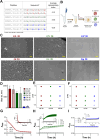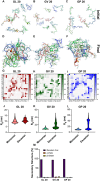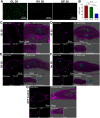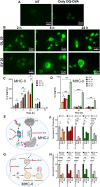Histidine-rich enantiomeric peptide coacervates enhance antigen sequestration and presentation to T cells
- PMID: 40171024
- PMCID: PMC11955804
- DOI: 10.1039/d5sc01163a
Histidine-rich enantiomeric peptide coacervates enhance antigen sequestration and presentation to T cells
Abstract
Peptides and peptidomimetics that self-assemble through LLPS have recently emerged as vital building blocks for creating functional biomaterials, thanks to their unique physicochemical properties and dynamic nature. One of life's most distinctive features is its selectivity for chiral molecules. To date, coacervates comprised of d-amino acids have not been reported. Here, we demonstrate that histidine-rich repeats of (GHGXY)4 (X = L/V/P) and their enantiomers undergo LLPS, paving the way for improved coacervate stability. Through a series of biophysical studies, we found that the droplet size can be tuned based on L, V, or P substitution, and molecular cargo between 600 and 150 000 Da is efficiently recruited in a bioactivity-preserving aqueous environment during phase separation. Mechanistic studies reveal that the droplets enter cells via energy-dependent endocytic pathways, exhibit composition-selective fusion properties, and effectively deliver molecular therapeutics across various cell types. Finally, we demonstrate that the coacervates enhance antigen presentation to CD4+ and CD8+ T cells, resulting in robust proliferation and the production of functional cytokines. Our study outlines the development and characterization of enantiomeric peptide coacervates as promising vaccine delivery vehicles with tunable physicochemical properties.
This journal is © The Royal Society of Chemistry.
Conflict of interest statement
There are no conflicts to declare.
Figures





Similar articles
-
How Droplets Can Accelerate Reactions─Coacervate Protocells as Catalytic Microcompartments.Acc Chem Res. 2024 Jul 16;57(14):1885-1895. doi: 10.1021/acs.accounts.4c00114. Epub 2024 Jul 5. Acc Chem Res. 2024. PMID: 38968602 Free PMC article.
-
Peptide-based coacervates as biomimetic protocells.Chem Soc Rev. 2021 Mar 21;50(6):3690-3705. doi: 10.1039/d0cs00307g. Epub 2021 Feb 22. Chem Soc Rev. 2021. PMID: 33616129 Review.
-
Selective amide bond formation in redox-active coacervate protocells.Nat Commun. 2023 Dec 21;14(1):8492. doi: 10.1038/s41467-023-44284-x. Nat Commun. 2023. PMID: 38129391 Free PMC article.
-
Peptide-Based Complex Coacervates Stabilized by Cation-π Interactions for Cell Engineering.J Am Chem Soc. 2025 Feb 5;147(5):4284-4295. doi: 10.1021/jacs.4c14469. Epub 2025 Jan 26. J Am Chem Soc. 2025. PMID: 39864072
-
Peptide Coacervates: Formation, Mechanism, and Biological Applications.ACS Appl Mater Interfaces. 2025 May 14;17(19):27697-27712. doi: 10.1021/acsami.5c04775. Epub 2025 Apr 30. ACS Appl Mater Interfaces. 2025. PMID: 40304369 Review.
Cited by
-
Biomolecule-Based Coacervation: Mechanisms, Applications, and Future Perspectives in Biomedical and Biotechnological Fields.Biomolecules. 2025 Jun 13;15(6):861. doi: 10.3390/biom15060861. Biomolecules. 2025. PMID: 40563500 Free PMC article. Review.
References
-
- Maricar S. Gudlur S. Miserez A. Anal. Chem. 2023;95:9924–9931. - PubMed
-
- Xu Z. Wang W. Cao Y. Xue B. Supramol. Mater. 2023;2:100049.
Grants and funding
LinkOut - more resources
Full Text Sources
Research Materials

